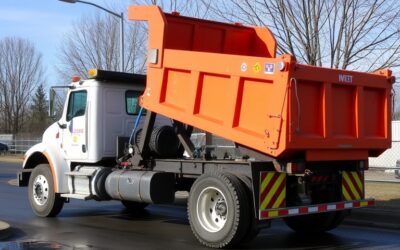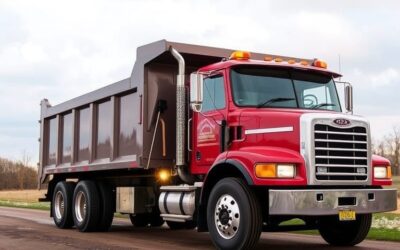Load stability in dump trucks is more than just a safety measure—it’s essential for efficient, accident-free operations. Imagine the chaos of a tip-over with heavy materials on uneven terrain—scary, right? Ensuring your load stays stable isn’t just about protecting your truck and cargo; it’s about safeguarding the driver and everyone else on the road.
Enter the Wink Anti-Tip device, your solution to load stability woes. This smart device automatically adjusts to keep your truck balanced and stable, reducing tip-over risks and making it easier to navigate challenging conditions. Understanding how it works and how to maintain load stability can transform your daily operations.
In this guide, we’ll explore why load stability matters, how Wink Anti-Tip enhances it, common challenges, and best practices to keep your operations smooth and safe.
Understanding Load Stability in Dump Trucks
Load stability in dump trucks hinges on evenly distributing weight to prevent tipping. An unstable load makes controlling the truck tricky, especially on uneven ground or during sharp turns. An unbalanced load shifts the truck’s center of gravity, boosting accident risks. That’s why maintaining load stability is non-negotiable for driver and cargo safety.
Factors like the type of materials and their distribution on the truck are crucial. Loose or unevenly spread materials can shift during transit, causing instability. Truck speed and road conditions also play critical roles. Drivers need to be vigilant about these factors to avoid accidents. Proper loading techniques and understanding the truck’s capacity are essential for maintaining stability.
How Wink Anti-Tip Enhances Load Stability
The Wink Anti-Tip device tackles load stability challenges head-on. This tech marvel continuously monitors your truck’s balance, alerting you if there’s a tipping risk. Its sensors detect instability and automatically lower the unit to restore balance.
One standout feature is its real-time adjustment capability. As your truck navigates rough or uneven terrains, the device makes immediate adjustments to maintain stability. This automatic recalibration helps you manage loads more effectively, even in tough conditions. Compatible with various dump trucks, including frameless, roll-off, and frame-type models, Wink Anti-Tip is a versatile solution for enhancing load stability.
Incorporating the Wink Anti-Tip device reduces tip-over risks and ensures safer, more efficient material transport. Understanding how this technology works can lead to more stable and secure dumping processes.
Benefits of Using Wink Anti-Tip for Different Dump Trucks
The Wink Anti-Tip device brings a host of benefits to different dump truck types, including frameless, roll-off, and frame-type dump trucks. Each type faces unique stability challenges, and Wink Anti-Tip is tailored to address these needs. For frameless trucks, which lack a solid frame’s support, the device’s real-time monitoring and automatic adjustments help maintain balance, even in tough conditions.
Roll-off dump trucks, with their high centers of gravity, benefit significantly from Wink Anti-Tip’s stability management. These trucks often carry heavy containers that can easily shift balance. The device’s alerts and stabilizing mechanisms prevent tipping during unloading. Frame-type dump trucks see improved load management as Wink Anti-Tip ensures even weight distribution, particularly on uneven surfaces.
Steps to Properly Implement Wink Anti-Tip on Your Dump Truck
Implementing the Wink Anti-Tip device on your dump truck is straightforward:
- Select the Mounting Location: Choose the best spot for the main unit, ensuring it doesn’t interfere with other components and provides stable support. Secure it with the provided brackets and screws.
- Install the Sensors: Place sensors at recommended points, typically the front and rear, for comprehensive monitoring. Secure them with screws or heavy-duty adhesive.
- Connect the Wiring: Carefully run the wires from the sensors to the main unit, securing them with zip ties. Ensure all connections are firm and protected from environmental factors.
- Mount the Control Panel: Install the control panel inside the truck’s cabin within easy reach of the driver for prompt response to alerts.
- Power On and Test: After installation, power on the device and run tests to ensure everything functions correctly. Familiarize operators with the device’s features and provide training on responding to alerts. Regular maintenance and checks ensure long-term reliability.
Common Installation Mistakes and How to Avoid Them
Avoid these common mistakes when installing the Wink Anti-Tip device to ensure optimal performance:
- Improper Sensor Placement: Sensors need accurate positioning to monitor stability effectively. Placing them too high or low gives inaccurate readings. Follow the manufacturer’s guidelines for precise sensor placement.
- Poor Wiring Connections: Loose or exposed wires lead to intermittent signals or system failure. Ensure all wiring is securely connected and protected from the elements. Use weatherproof connectors and secure wires with zip ties.
- Inadequate Testing: Failing to test thoroughly after installation is critical. Comprehensive tests in various operational scenarios ensure the device functions correctly. Train operators on using the system and responding to alerts for effective implementation.
Testing and Verifying Your Installed Wink Anti-Tip Device
Once installed, it’s crucial to test and verify the Wink Anti-Tip device to ensure it works as expected:
- Power On: Ensure all components, including sensors and the control panel, receive power. Check that the device initializes correctly without error messages.
- Perform Tests: Simulate operational scenarios like uneven loading or driving on inclines. Observe how the Wink Anti-Tip device responds. Sensors should detect tipping risks and activate alerts and adjustments. Verify that the control panel reflects these changes and alerts the driver.
- Regular Maintenance: Conduct regular maintenance checks even after successful installation and initial testing. Periodically inspect wiring, sensor placement, and overall performance. Immediate troubleshooting ensures long-term reliability.
Following these steps ensures the Wink Anti-Tip device operates effectively, enhancing your dump truck’s safety.
Conclusion
The Wink Anti-Tip device is essential for enhancing dump truck safety by actively preventing tip-over accidents. Understanding the common causes of these accidents and how the device works helps drivers appreciate its importance. Implementing best practices ensures the device operates at its full potential, providing a safer environment for dump truck drivers and those around them.
Equipping your dump truck with the Wink Anti-Tip device is a proactive approach to safety. The benefits extend beyond just the driver, impacting overall operations and community safety. Make the investment in safety today.
To learn more about how our anti-tip device can enhance your dump truck safety, contact us at Wink Anti-Tip today and take the first step towards a safer driving experience!





